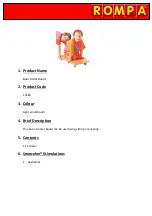
Symptom
Component
Check
Order
Notes
Solution
2.Decreased
Run Time
(cont).
2.3. Brake
Drag.
Ensure that both of the cable
operated disc/band or V-brake that
are fitted to your OSET are correctly
adjusted, as any unnecessary
contact between pad material and
rotor of brake shoe, will cause
friction which ultimately the motor
must overcome by drawing power
from the batteries more quickly.
1. Cable Operated Brakes (16.0 & 12.5): Check the
cable can move freely within the cable outer, look
for any wear in the cable, debris or corrosion that
could cause it to snag. Ensure that the cable is well
lubricated. A cable oiler is a useful tool for this.
2. Hydraulic Brakes (20.0): Remove the brake pads
& ensure the slave pistons are able to return freely.
Clear any debris behind the brake pad &
surrounding the pistons and lubricate if necessary.
A lazy piston could cause the brake to rub.
2. Disc Brake Models (16.0): Ensure that the rotor
is central in the calliper, and that the rotor is
running straight and true.
3. Front V-Brake models (12.5): Ensure brake pads
are orientated so they are parallel to the rim, that
they will contact the rim only and not the tyre, and
importantly that the rim runs straight and true.
4. Rear Band Brake Models (2007 16.0 24v): Ensure
the brake shoe is free from debris and corrosion,
and that the ‘band’ mechanism itself is well
lubricated.
13
Содержание 2012 12.5 24V
Страница 31: ...31...














































